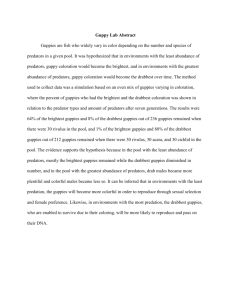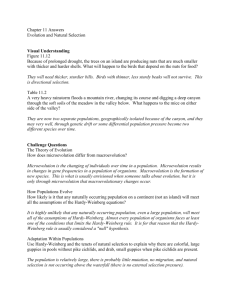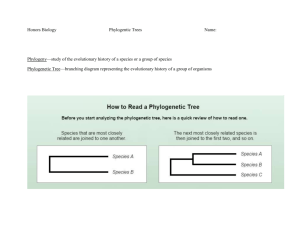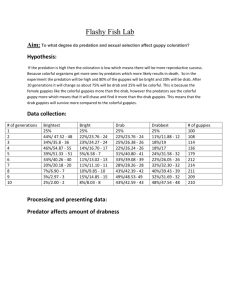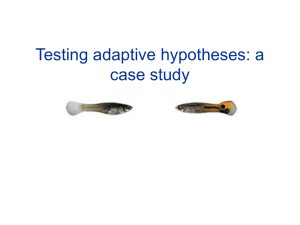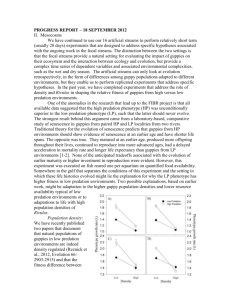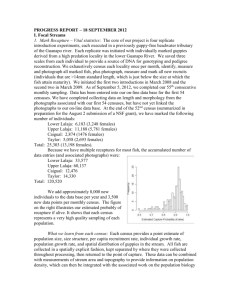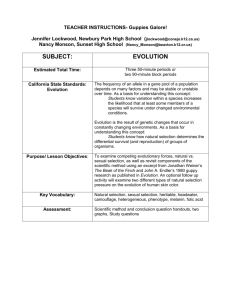basic mechanism of evolution
advertisement
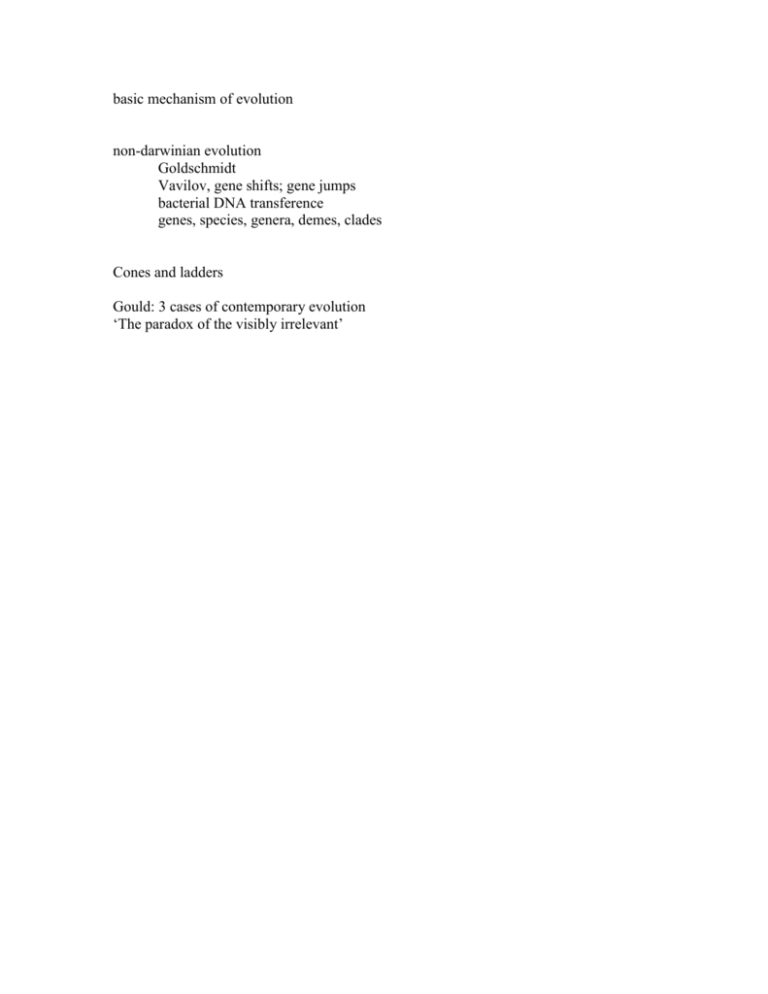
basic mechanism of evolution non-darwinian evolution Goldschmidt Vavilov, gene shifts; gene jumps bacterial DNA transference genes, species, genera, demes, clades Cones and ladders Gould: 3 cases of contemporary evolution ‘The paradox of the visibly irrelevant’ Teleology persists in the view of nature Contemporary Image of the Bush 1. Guppies from Trinidad. In many drainage systems on the island of Trinidad, populations of guppies live in downstream pools, where several species of fish can feed upon them. "Some of these species prey preferentially on large, mature-size classes of guppies." (I take all quotes from the primary technical article that inspired later press accounts. "Evaluation of the Rate of Evolution in Natural Populations of Guppies [Poecilia reticulata]," by D. N. Reznick, F. H. Shaw, F. H. Rodd, and R. G. Shaw, published in Science, vol. 275, 1977.) Other populations of the same species live in "upstream portions of each drainage," where most "predators are excluded ... by rapids or waterfalls, yielding low-predation communities." In studying both kinds of populations, Reznick and colleagues found that "guppies from high-predation sites experience significantly higher mortality rates than those from lowpredation sites." They then reared both kinds of guppies under uniform conditions in the laboratory and found that fishes from high-predation sites in lower drainages matured earlier and at a smaller size. "They also devote more resources to each litter, produce more, smaller offspring per litter, and produce litters more frequently than guppies from low-predation localities." This combination of observations from nature and the laboratory yields two important inferences. First, the differences make adaptive sense, for guppies subjected to greater predation would fare better if they could grow up fast and reproduce both copiously and quickly before the potential boom falls -- a piscine equivalent of the old motto for electoral politics in Boston: vote early and vote often. On the other hand, guppies in little danger of being eaten might do better to bide their time and grow big and strong before engaging their fellows in any reproductive competition. Second, since these differences persist when both kinds of guppies are reared in identical laboratory environments, they must be based upon evolved and inherited distinctions between the populations. In 1981, Peznick transferred some guppies from high-predation downstream pools into low-predation upstream waters then devoid of guppies. These transplanted populations evolved rapidly to adopt the reproductive strategy favored by indigenous populations in neighboring upstream environments: delayed sexual maturity at a larger size, and longer life. Moreover, Reznick and colleagues made the interesting observation that males evolved considerably more rapidly in this favored direction. In one experiment, males reached their fun extent of change within four years, while females were still evolving after eleven years. Since the laboratory populations had shown higher heritability for these traits in males than in females, these results make good sense. (Heritability is, roughly, the correlation between traits in parent and offspring due to genetic differences. The greater the heritable basis of a trait, the faster it can evolve by natural selection.) This favorable set of circumstances -- rapid evolution in a predictable and presumably adaptive direction based on traits known to be higly heritable -- provides a "tight" case for well-documented (and sensible) evolution at scales well within the purview of human observation, a mere decade in this case. The headline for the news report of this paper in Science magazine (March 28, 1997) read "Predator-free Guppies Take an Evolutionary Leap Forward." 2. Lizards from the Exuma Cays, Bahama Islands. During most of my career, my fieldwork has centered on the biology and paleontology of the land snail Cerion in the Bahama Islands. During these trips, I have often encountered fellow biologists devoted to other creatures; we all, I trust, feel a shared bond of collegiality and comradeship. In one major program of research, Tom Schoener (a biology professor at the University of California, Davis) has, with numerous students and colleagues, been studying the biogeography and evolution of the ubiquitous little lizard Anolis (see "Darwin's Lizards," page 34) -- for me just a fleeting shadow running across a snail-studded ground, but for them a focus of utmost fascination (while my beloved snails must just blend into their immobile background). In 1977 and 1981, Schoener and colleagues transplanted populations of five to ten lizards from Staniel Cay in the Exuma chain to fourteen small, neighboring islands that housed no lizards. In 1991, they found that the lizards had thrived (or at least survived and bred) on most of these islands, and they collected samples of adult males from each island with an adequate population. In addition, they gathered a larger sample of males from areas on Staniel Cay that had served as the source for original transplantations. This study then benefits from general principles learned by extensive research on numerous Anolis species throughout the Bahamas. In particular, relatively longer limbs permit greater speed, a substantial advantage provided that preferred perching places can accommodate long legged lizards. Trees and other "thick" perching places therefore favor the evolution of long legs. Staniel Cay itself includes a predominant forest, and the local Anolis tend to be long legged. But when lizards must live on thin twigs in bushy vegetation, the agility provided by shorter legs (on such precarious perches) may outweigh the advantages in speed that longer legs would provide. Thus, lizards living on narrow twigs tend to be shorter legged. The small cays that received the fourteen transported populations tend to lack forest and to be covered with bushy vegetation (and narrow twigs). J.B. Losos, the principal author of the new study, therefore based an obvious prediction on these generalities. The populations had been transferred from forests with wide perches to bushy islands covered with narrow twigs. "From the kind of vegetation on the new islands," Losos stated, "we predicted that the lizards would develop shorter hindlimbs." The study, published in Nature, vol. 387, 1997, validates this expected result: a clearly measurable change, in the predicted and adaptive direction, in less than twenty years. This study lacks a crucial piece of documentation that the Trinidadian guppies did provide -- an absence immediately noted by friendly critics and fully acknowledged by the authors. Losos and colleagues have not studied the heritability of leg length in Anolis sagrei and therefore cannot be certain that their results record a genetic process of evolutionary change. Perhaps leg length is development mentally plastic, so that the same genes yield longer legs if lizards grow up on trees and shorter legs if they always cavort in the bushes (just as the same genes can lead to a thin or fat human being depending upon a personal history of nutrition and exercise). In any case, however, a sensible and apparently adaptive change in average leg length has occurred within twenty years on several islands, whatever the cause of modification. 3. Snails from Great Inagua, Bahama Islands. Most of Great Inagua, the second largest Bahamian island (Andros wins first prize), houses a large and ribby Cerion species named C. rubicundum. But fossil deposits of no great age lack this species entirely and feature instead an extinct form named C. excelsior, the largest of all Cerion species. Several years ago, on a mud flat in the southeastern comer of Great Inagua, David Woodruff (of the University of California, San Diego) and I corrected a remarkable series of shells that seemed to span (and quite smoothly) the entire range of form from extinct C. excelsior to modern C. rubicundum. Moreover, and in general, the more eroded and "older looking" the shell, the closer it seemed to lie to the anatomy of extinct C. excelsior. This situation suggested a local evolutionary transition by hybridization, as C. rubicundum, arriving on the island from an outside source, interbred with indigenous C. excelsior. Then, as C. excelsior declined toward extinction while C. rubicundum thrived and increased, the average anatomy of the population transformed slowly and steadily in the direction of the modern form. This hypothesis sounded good and sensible, but we could devise no way to test our idea -- for all the shells had been collected from a single mud flat (analogous to a single bedding plane of a geological stratum), and we could not determine their relative ages. The pure C. excelsior shells "looked" older, but such personal impressions (subject as they are to a researcher's bias) count for less than nothing in science. So we were stymied and put the specimens in a drawer. Several years later, I teamed up with paleontologist and geochemist Glenn A. Goodfriend, from the Carnegie Institution of Washington. He had refined a dating technique based on changes in the composition of amino acids in the shell over time. By keying these amino acid changes to radiocarbon dates for some of the shells, we were able to estimate the age of each shell. A plot of shell age versus position on an anatomical spectrum from extinct C. excelsior to modern C. rubicundum produced a beautiful correlation between age and anatomy: the younger the specimen, the closer to the modern anatomy. This 10,000- to 20,000-year transition by hybridization exceeds the Trinidad and Exuma studies by three orders of magnitude in time (that is, 1,000-fold), but even 10,000 years represents a geological eyeblink in the fullness of evolutionary time. The transformation marks a full change from one species to another, not just a small decrement of leg length or a change in the timing of breeding within a single species. (For details, see G. A. Goodfriend and S.J. Gould, "Paleontology and Chronology of Two Evolutionary Transitions by Hybridization in the Bahamian Land Snail Cerion," Science, vol. 274, 1996). Harvard University's press release (with no input from me) carried the headline "Snails Caught in Act of Evolving."

